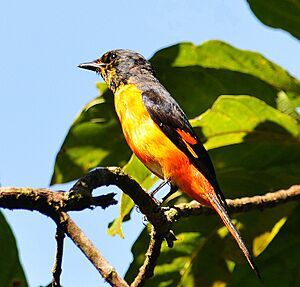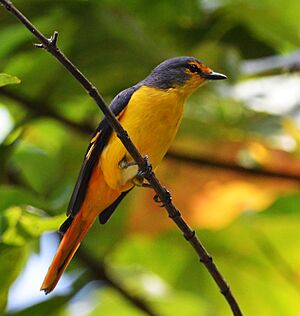Fiery minivet facts for kids
Quick facts for kids Fiery minivet |
|
|---|---|
 |
|
| Male | |
 |
|
| Female | |
| Conservation status | |
| Scientific classification |
The fiery minivet (Pericrocotus igneus) is a colorful bird that lives in parts of Asia. You can find it in countries like Thailand, Malaysia, Indonesia, and the Philippines. These birds like to live in different kinds of forests, including coastal areas. Sadly, their homes are shrinking because forests are being cut down. Because of this, the fiery minivet is considered a "near-threatened" species by the International Union for Conservation of Nature (IUCN).
Contents
What's in a Name?
The fiery minivet got its scientific name, Pericrocotus igneus, from a scientist named Edward Blyth in 1846. The word igneus comes from Latin and means "fiery," which perfectly describes the male bird's bright colors! Scientists also found that the fiery minivet is closely related to another bird called the small minivet. They are like "sister species."
What Does It Look Like?
The fiery minivet is a medium-sized bird, about 15 to 16.5 centimeters (6 to 6.5 inches) long. Male and female fiery minivets look quite different from each other. This is called being "sexually dimorphic."
Male Fiery Minivet
The male bird is very striking. Its head and back are a shiny black color. Its lower back is a bright orange-red. Its wings are mostly glossy black, but they have patches and edges of orange-red feathers. The tail is black and orange-red, fading from one color to the other. The male's chin and throat are also shiny black, and the rest of its belly is orange-red. It has dark brown eyes and a black beak and feet.
Female Fiery Minivet
The female fiery minivet has a grey head. Around her eyes and nose area (called "lores"), she has orange markings. Her back is a lead grey color, but her rump (the area above her tail) is orange-red. Her wings are a darker grey, and the bright patch on her wings is paler than the male's. The female's belly and chest are yellow.
Young Fiery Minivets
Young fiery minivets look different from their parents. Their upper parts are a sooty brown, and their flight feathers are sooty black. Their chin and upper belly are off-white, and the rest of their belly is pale yellow. After they grow new feathers, they start to look more like the adult female.
Where Do They Live?
You can find the fiery minivet in several places across Southeast Asia. These include parts of Myanmar (Tenasserim), the Thai-Malay Peninsula, the island of Sumatra and its smaller islands, Borneo, and Palawan in the Philippines. Sadly, they are no longer found in Singapore.
These birds prefer to live high up in the trees. They like lowland broadleaf forests, the edges of forests, and even swampy forests. They can also be found in forests that have grown back after being cut down, and in coastal areas like mangrove forests. They usually live below 600 meters (about 2,000 feet) in height, but sometimes they can be found up to 1,200 meters (about 4,000 feet) high. Sometimes, they might even visit gardens with trees near forests.
Behaviour and Life Cycle
Fiery minivets often fly around in groups. They also join "mixed-species foraging flocks," which means they hunt for food with other types of birds. Their call sounds like a "swee-eet" or "twee-eet."
They are good at catching insects. They grab insects right out of the air or pick them off leaves and branches.
Reproduction
Fiery minivets usually breed between May and July. They build a shallow, cup-shaped nest in the fork of a tree. They use small twigs and plant fibers to build it. To hide their nest, they decorate it with lichen and pieces of tree bark, making it blend in with the tree. The eggs they lay are pale yellowish and have brown and grey spots.
Why Are They in Danger?
The fiery minivet is considered a near-threatened species. This means their numbers are decreasing, and they could become endangered if things don't change.
The main reason their population is shrinking is deforestation. Forests are being cut down for logging (to get wood) and to clear land for other uses. Forest fires are also a big threat to their homes, like the large fires that happened in 1997 and 1998. These activities destroy the places where fiery minivets live and find food.


